1852 1ed Life of Winfield Scott with Civil War Union General Tillson Provenance

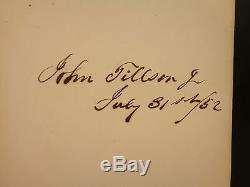
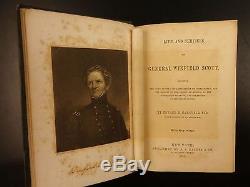
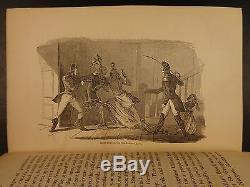
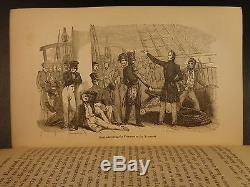
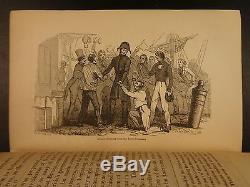
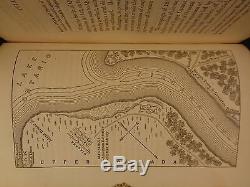
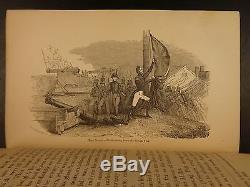
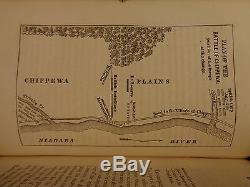
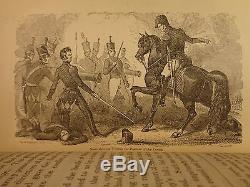
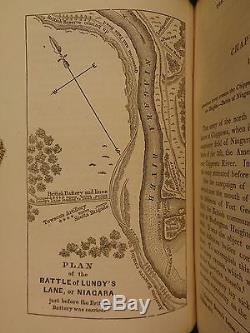
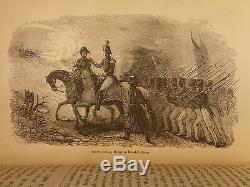


Life of Winfield Scott with Civil War Union General Tillson Provenance! This work is a biographical collection of stories and military encounters of Winfield Scott. Winfield Scott (1786 1866) was a United States Army general, and unsuccessful presidential candidate of the Whig Party in 1852. Civil War Union General provenance! Life and services of General Winfield Scott : including the siege of Vera Cruz, the battle of Cerro Gordo, and the battles in the valley of Mexico, to the conclusion of peace, and his return to the United States.
Illustrated throughout with full-page engravings and maps. Provenance: John Tillson J[r]. General John Tillson was a decorated Union officer in the Civil War. He commanded a brigade in Shermans march to the sea and beyond. Wear as seen in photos.Complete with all [xi], 536 pages; plus indexes, prefaces, and such. 7.5in X 5in (19cm x 23cm).
Winfield Scott (June 13, 1786 May 29, 1866) was a United States Army general, and unsuccessful presidential candidate of the Whig Party in 1852. Known as "Old Fuss and Feathers" and the "Grand Old Man of the Army, " he served on active duty as a general longer than any other person in American history, and many historians rate him the best American commander of his time. Over the course of his 53-year career, he commanded forces in the War of 1812, the Black Hawk War, the MexicanAmerican War, the Second Seminole War, and, briefly, the American Civil War, conceiving the Union strategy known as the Anaconda Plan that would be used to defeat the Confederacy.
He served as Commanding General of the United States Army for twenty years, longer than any other holder of the office. A national hero after the MexicanAmerican War, he served as military governor of Mexico City. Such was his stature that, in 1852, the United States Whig Party passed over its own incumbent President of the United States, Millard Fillmore, to nominate Scott in that year's United States presidential election. At six feet five inches tall, he remains the tallest man ever nominated by a major party.Scott lost to Democrat Franklin Pierce in the general election, but remained a popular national figure, receiving a brevet promotion in 1855 to the rank of lieutenant general, becoming the first American since George Washington to hold that rank. 3.1 Lieutenant Colonel at Queenston Heights.
3.2 Colonel at Fort George. 3.3 Brigadier General at Chippawa and Lundy's Lane. 3.4 Brevet Major General. 4 After the War of 1812. 9 Authorship of manual on tactics.
11.3 Saint Patrick's Battalion. 11.5 Conflict with American civil authorities. 12.1 1840 presidential campaign.
12.2 1852 presidential campaign. Coat of Arms of Winfield Scott. Winfield Scott was born to William Scott (17471791), a farmer and veteran of the American Revolution who served as an officer in the Dinwiddie County militia, and Ann Mason (17481803) on Laurel Branch, the family plantation in Dinwiddie County, Virginia, near Petersburg, Virginia, on June 13, 1786. [3] He was educated by tutors and in the local schools, and briefly attended the College of William and Mary.He then studied law in the office of attorney David Robinson, where his contemporaries included Thomas Ruffin. Scott attained admission to the bar, and made a brief attempt to practice law. He also gained his initial military experience as a corporal of cavalry in the Virginia militia near Petersburg in 1807, during the response to the ChesapeakeLeopard Affair.
Scott's long career in the United States Army began when Senator William Branch Giles of Virginia arranged for Scott to be interviewed by Henry Dearborn, the Secretary of War, and President Thomas Jefferson. He was subsequently commissioned as a captain in the Light Artillery in May 1808, shortly before his 22nd birthday. Scott's early career in the army was tumultuous.Scott openly criticized the then Commanding General of the Army, James Wilkinson over Wilkinson's refusal to follow orders and remove troops from an unhealthy bivouac site he owned near New Orleans, which caused several illnesses and deaths. Scott's commission was suspended for one year, and after returning to duty, he served in New Orleans on the staff of General Wade Hampton from 1811 to 1812. Scott earned the nickname "Old Fuss and Feathers" for his insistence on military bearing, courtesy, appearance and discipline. In his own campaigns after reaching high rank, Scott preferred to use a core of Army regulars augmented by volunteers whenever possible.
Scott perennially concerned himself with the welfare of his men, as demonstrated by his quarrel with Wilkinson over the New Orleans bivouac site. In another instance, when cholera broke out at a post under his command, Scott was the only officer who stayed to nurse the stricken enlisted men.Scott during the War of 1812. Lieutenant Colonel at Queenston Heights[edit]. The army promoted Scott to lieutenant colonel of the 2nd Artillery Regiment in July 1812. Scott served primarily on the Niagara Campaign front in the War of 1812. He took command of an American landing party during the Battle of Queenston Heights (Ontario, Canada) on October 13, 1812.
Most New York militia members refused to cross into Canada in support of the invasion, and the British compelled New York militia commander Brigadier General William Wadsworth and Scott, the Regular Army commander, to surrender. The British held Scott as a prisoner of war. The British considered Irish-American prisoners of war British subjects and traitors and executed 13 such Americans captured at Queenstown Heights.
The Senate wrote a bill after this urging, but President James Madison believed the summary execution of prisoners of war unworthy of civilized nations and so refused to enforce the act. Colonel at Fort George[edit]. Scott was promoted to colonel in March 1813. [4] Scott planned and led the capture of Fort George, Ontario, on the Niagara River. By crossing the Niagara and landing on the Lake Ontario shore, Scott forced the British to abandon Fort George. Colonel Scott was wounded in this battle, which is considered among the best-planned and best-executed U.Brigadier General at Chippawa and Lundy's Lane[edit]. Scott was promoted to brigadier general on March 19, 1814. He was only 27 years old at the time, one of the youngest generals in the history of the U. Scott commanded the 1st Brigade, and was instrumental in the decisive American success at the Battle of Chippawa on July 5, 1814. Scott had a major role in the bloody Battle of Lundy's Lane on July 25, and suffered serious wounds.
The American commander, Major General Jacob Brown, and the British-Canadian commander, Lieutenant General Gordon Drummond, were also wounded. For his valor at Lundy's Lane, Scott received a brevet i. An honorary promotion to major general to date from July 25, 1814. However, the severity of his wounds prevented his return to active duty for the remainder of the war. In 1815, Scott was admitted as an honorary member of the Pennsylvania Society of the Cincinnati in recognition of his service in the War of 1812. [6] Scott's Society of the Cincinnati insignia was a one of a kind solid gold eagle measuring nearly three inches in height, making it one of the most impressive military society insignias ever produced. [7] There are, however, no known portraits or photographs of Scott wearing the insignia. Scott's insignia is in the collection of the West Point Museum. After the War of 1812[edit]. From the War of 1812 until Scott became commanding general of the U.Army in 1841, Scott had a rivalry with Brevet Major General Edmund P. The central issue was the question of which had seniority; should brevet ranks count, which would favor Scott, or were regular Army ranks what mattered, which would favor Gaines. Scott claimed he outranked Gaines because Scott's brevet rank of major general, dated July 25, 1814 made him senior to Gaines, whose brevet was dated August 15, 1814.
Gaines argued that he should be senior; his and Scott's promotions to brigadier general, colonel, and lieutenant colonel were all issued on the same dates, but Gaines had been promoted to major first. The dispute was important to both because they realized that assignment as the Army's commanding general might be at stake. Gaines became increasingly marginalized as Scott continued to gain influence, and died in 1849 while still on active duty.
Scott supervised the preparation of the first standard drill regulations for the Army and headed a postwar officer retention selection board in 1815. He also served as president of Board of Tactics in 1815. [4] Scott visited Europe to study French military methods in 1815/1816. [4] He translated several military manuals of Napoleon I of France into English. Scott held regional command in the Division of the North in 1816.Mayo (1789-June 10, 1862[8]) in 1817. Scott served as president of the Board of Tactics in 1821, 1824 and 1826. [4] He commanded the Eastern Department in 1825. Scott and Gaines were passed over for the commanding general's post in 1828, following the death of Jacob Brown. Aware of the Scott/Gaines rivalry, President John Quincy Adams nominated Alexander Macomb, who had been a brigadier general, but agreed to reduction in rank to colonel in order to serve as the Army's chief of engineers.
Scott attempted to resign, but it was not accepted. Scott again visited Europe and then resumed command of the Eastern Department in 1829. [4] Upon direction of the War Department, Scott in 1830 published Abstract of Infantry Tactics, Including Exercises and Manueuvres of Light-Infantry and Riflemen, for the Use of the Militia of the United States for the use of the American militia. Winfield Scott, 1835 portrait by George Catlin. Cholera among his reinforcing troops prevented Scott from taking field command during the Black Hawk War. In late November and early December 1832, Scott organized U. Army troops for possible enforcement of President Andrew Jackson's authority during the Nullification Crisis.In late 1832 and early 1833 Scott served as an emissary from President Jackson to South Carolina. His tactful diplomacy and the use of his troops in suppressing a major fire in Charleston did much to defuse the crisis. In 1832, Scott replaced John E. Wool as commander of Federal troops in the Cherokee Nation lands in Georgia.
Scott commanded the field forces in Second Seminole War and Creek War in 1836. Scott was recalled to Washington due to the highly politicized nature of the tactics he employed and the huge expenditures incurred in policing the frontier, compounded by controversies between regular army and local militia officers. Brigadier General Edmund Meredith Shackelford was appointed commander in the area by President Jackson until Brigadier General Thomas Jesup could arrive.
A court of inquiry later cleared Scott of wrongdoing in the Seminole and Creek operations. Scott felt that his recall was a political intrigue.
In 1845, Shackelford wrote to Jackson for a clarifying statement that Shackelford had had no part in Scott's recall to Washington. Scott assumed command of the Eastern Division in 1837.
Scott was responsible for maintaining order on the Canadian border, where the Patriot War threatened to entangle the U. In the Upper Canada Rebellion. Presidents Jackson and Van Buren, ignoring the Supreme Court's ruling in Worcester v. Georgia, tacitly supported Georgia's expulsion of the Cherokees. In 1838, Scott was placed in charge of enforcing the Treaty of New Echota, including removal of the Cherokees to the "Indian Territory" (now Oklahoma).
Van Buren put Scott in command of the "Army of the Cherokee Nation", headquartered at Fort Cass and Fort Butler. Statue of Winfield Scott on Scott Circle in Washington, D.Arriving at New Echota, Cherokee Nation, on April 6, 1838, Scott immediately divided the Cherokee Nation into three military districts. He designated May 26, 1838 as the beginning date for the first phase of the removal. The first phase involved the Cherokees in Georgia. Scott wanted Army regulars rather than Georgia militia for this operation, because the militia had personal gains at stake; some claimed Cherokee land.
[10] The promised regulars did not arrive in time, so Scott proceeded with 4,000 Georgia militia. The moral implications of the Jackson-Van Buren policies did not make Scott's role easy. Representative (and ex-President) John Quincy Adams opposed the removal, imputing it to "Southern politicians and land grabbers;" many Americans agreed.
[11] Scott reassured the Cherokee people of proper treatment. In his instructions to the militia, Scott called any acts of harshness and cruelty abhorrent to the generous sympathies of the whole American people. " Scott also admonished his troops not to fire on any fugitives they might apprehend unless they should "make stand and resist. " Scott detailed help to render the weak and infirm: "Horses or ponies should be used to carry Cherokees too sick or feeble to march.
" Also, "Infants, superannuated persons, lunatics, and women in a helpless condition with all, in the removal [deserve] peculiar attention, which the brave and humane will seek to adopt to the necessities of the several cases. Scott's good intentions, however, did not adequately protect the Cherokees from terrible abuses, especially at the hands of lawless rabble that followed on the heels of the soldiers to loot and pillage. [11] At the end of the first phase of the removal in August 1838, 3,000 Cherokees left Georgia and Tennessee by water toward Oklahoma, but camps still retained another 13,000.By the intercession of Chief John Ross in Washington, these Cherokees traveled under their own auspices, unarmed, and free of supervision by militiamen or regulars. Though government contractors, steamboat owners, and others who stood to profit protested, Scott carried out this new policy. Ex-President Jackson demanded of the Attorney General the replacement of Scott and the arrest of Chief Ross. Within months, Scott captured (or killed) every Cherokee in north Georgia, Tennessee, and Alabama who could not escape.
His troops reportedly rounded up the Cherokee and held them in rat-infested stockades with little food. Burnett later wrote, Future generations will read and condemn the act and I do hope posterity will remember that private soldiers like myself, and like the four Cherokees who were forced by General Scott to shoot an Indian Chief and his children, had to execute the orders of our superiors.We had no choice in the matter. More than 4,000 Cherokee died in this confinement before ever beginning the trip west. As the first groups herded west died in huge numbers in the heat, the Cherokee pleaded with Scott to postpone the second phase of the removal until autumn, and he complied.
Determined to accompany them as an observer, Scott left Athens, Georgia, on October 1, 1838 and traveled with the first "company" of a thousand people, including both Cherokees and black slaves, as far as Nashville. [16] The Cherokee removal later became known as the Trail of Tears.
When Brigadier General Winfield Scott reached Nashville, superiors abruptly ordered him to return to Washington to deal with troubles on the Canadian border. On this assignment, he helped defuse tensions between officials of the state of Maine and the British colony of New Brunswick in the undeclared and bloodless Aroostook War in March 1839. Authorship of manual on tactics[edit]. In 1840, Scott wrote Infantry Tactics, Or, Rules for the Exercise and Maneuvre of the United States Infantry.
This three-volume work served as the standard drill manual for the United States Army until William J. Hardee's Tactics, published in 1855. On June 25, 1841 Macomb died, and Scott and Gaines were the obvious choices to succeed him.
John Bell, the Secretary of War, had no interest in rekindling the Scott/Gaines seniority dispute; he quickly recommended Scott to President John Tyler. Tyler approved, and Scott assumed office as commanding general on July 5, 1841. He was promoted to major general, then the highest rank in the Army, with June 25, 1841 as his date of rank.
As commanding general of the Army, Scott took great interest in the professional development of the cadets of the United States Military Academy. A drawing of Scott at the battle of Veracruz. During the MexicanAmerican War, Major General Scott was appointed by President James K. Polk to lead an army of regulars and volunteers to the Rio Grande for a hasty campaign.[19] During the planning and initial movement, worsening political tensions between Scott and president, led to a very public shellacking and relief of Scott as field commander. With reluctance, Zachary Taylor was charged with leading the charge to the Rio Grande. While Taylor was largely successful in securing the northeastern provinces of Mexico after war broke out, it became obvious by the mid-1846, the Mexicans would not surrender the captured territories without a direct assault on their capital.
Deeming an overland campaign from northeastern Mexico unfeasible (required marching over 900 km of arid Mexican desert), Scott planned an expedition to Gulf port city of Veracruz. As Taylor gained notoriety for victories in northeastern Mexico, Polk became increasingly reluctant to posture Taylor for a presidential run post-bellum. Further, Polk and his cabinet had reasonable doubts whether Taylor could lead the complex operation. Left to choose between Taylor and Scott, Polk reluctantly chose Scott at the behest of his cabinet.
Even while Scott was en route to the theater of operations, Polk continued to search for a fellow Democrat to command the expedition in lieu of Scott. Butler and Robert Patterson were both selected as early options, but neither were deemed acceptable by Congress. Patterson, who was Irish-born and not eligible to be President, was dismissed early on as a suitable choice. Butler's capacity to command an army was questionable at best, never seeing combat and lacking experience in the regular Army. Landing at Veracruz on March 9, 1847, Scott, assisted by one of his staff officers, Captain Robert E.
Lee, and perhaps inspired by William H. Prescott's History of the Conquest of Mexico, followed the approximate route taken by Hernán Cortés in 1519, and assaulted Mexico City. Scott's opponent in this campaign, Mexican president and general Antonio López de Santa Anna, had just suffered a crushing defeat at Buena Vista and faced impending revolt by the Mexican populace. Santa Anna chose to meet Scott after the landing, assuming the American force to be significantly degraded after a costly offense on the well-fortified Vera Cruz.
Despite high heat, rains, and difficult terrain, Scott won the battles of Cerro Gordo on April 18, 1847, Contreras/Padierna on August 1920, 1847, Churubusco on August 20, 1847, and Molino del Rey on September 8, 1847. He then assaulted the fort of Chapultepec on September 13, 1847, after which Mexico City surrendered. When the Duke of Wellington, victor of Waterloo, learned that Scott had succeeded against alarming odds in capturing Mexico City, he proclaimed Scott, the greatest living general. The item "1852 1ed Life of Winfield Scott with Civil War Union General Tillson Provenance" is in sale since Tuesday, October 4, 2016. This item is in the category "Books\Antiquarian & Collectible". The seller is "schilb_antique_books" and is located in Columbia, Missouri. This item can be shipped worldwide.- Subject: Americana
- Binding: Hardcover
- Special Attributes: 1st Edition
- Year Printed: 1852
- Language: English
- Original/Facsimile: Original


